#nonbinary historian
Explore tagged Tumblr posts
Text
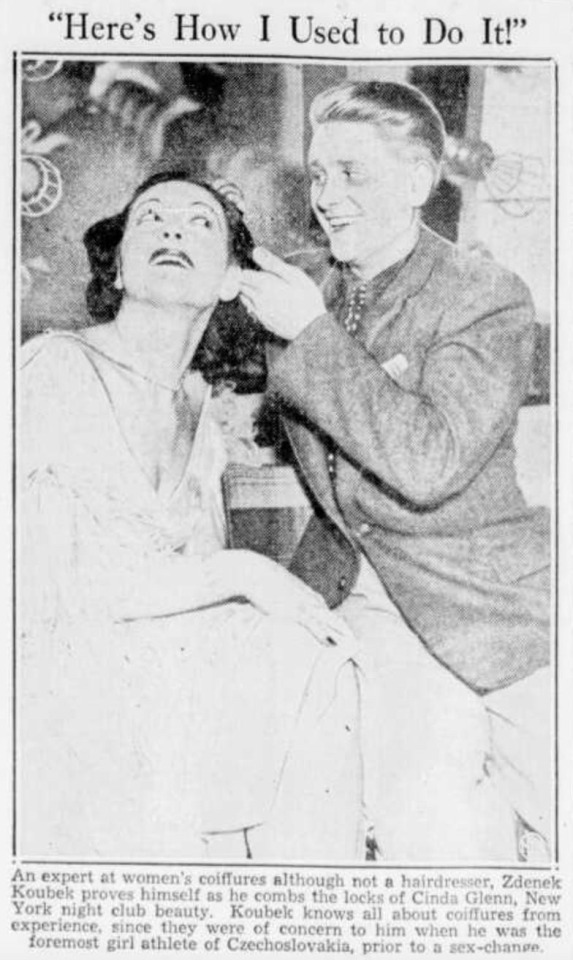
ID: a black and white photo and caption from a newspaper showing a young white trans man with light hair wearing a tweed jacket and high collar smiling at a young white woman in a pale dress as he brushes her mid-length dark hair. She is smiling at him from the slightly complex angle as he brushes her hair. The photo is faded and not great quality but their faces are clear.
The headline over the photo is “Here’s How I Used To Do It!”
The caption below reads “An expert at women's coiffures although not a hairdresser, Zdenek Koubek proves himself as he combs the locks of Cinda Glenn, New York night club beauty. Koubek knows all about coiffures from experience, since they were of concern to him when he was the foremost girl athlete of Czechoslovakia, prior to a sex-change.”
Zdenek Koubek was born in Paskov, Czechoslovakia (at the time) in December 1913, one of eight siblings, and competed as an athlete. With minimal formal training, he began running at age 17, decided to pursue it formally aged 19, and broke two world records at the 1934 world olympics.
Because queer and gender-diverse history is complex, I’m genuinely unsure if Zdenek was intersex. He seems to have been pretty gender-nonconforming when read as a woman in his early life and seems to have retired from athletics because he was harassed by people wanting him to undergo invasive “gender checks” after his gold medals at the 1934 Olympics.
Apparently the current obsession with “defining gender in sport” has roots back to the 1930s. Athletes competing in female athletics have been forced to undergo a variety of examinations for the purpose of declaring them “female enough”. They seem to have never been pleasant, appropriate, or anything other than invasive and dehumanising, and they seem to have always focused on a) defining gender by physicality b) defined that physicality in fairly arbitrary ways that are actually incredibly difficult to relate to anything objective, despite a veneer of scientific objectivity.
I can entirely see why the threat of such harassment would have caused Zdenek to decide an athletic or adjacent career wasn’t worth undergoing it, whether he personally believed himself to be intersex or whether we would recognise him as such today. The term “intersex” has many definitions, and is often challenged by medical professionals if it could potentially cover too many people - e.g. medical professionals have repeatedly challenged the term when used by AFAB people with PCOS, which can cause fertility issues, hirstutism etc, purely on the grounds of “that would make around 10% of women intersex”. Zdenek simply publicly stated “I was wrongly assigned as female at birth” without giving any other details - as he had *every* right to. Some historians have characterised him as intersex based on this, and others simply as trans; he appears, very reasonably, to have preferred to preserve his privacy on the details.
Zdenek went on a lecture tour of the US talking about his life and transitioned in 1936. At the time of this photo, he was pursuing a career in cabaret in the US. He seems to have been reasonably successful but never settled there, returning home and marrying a cis woman with whom he lived happily for the rest of his life, dying in Prague aged 72 in 1986.
He joined a local rugby team along with his brother Jaroslov after WWII and seems to have been an enthusiastic amateur player. I hope he got a lot of joy out of it, which he does seem to have.
Like so many queer and trans histories, Zdenek’s is somewhat obscured because so much of what has been written about him is always skewed by the writer’s own perspectives about gender and transness. Including the drive to impose a false binary on trans experience - which I as a nonbinary person know is certainly not universally present.
There are, of course, *absolutely* trans people who always have a strong feeling of gender equating to “knowing they are a boy/girl from an early age”, and I in no way wish to erase them or their experiences, but it must also be noted and acknowledged there are plenty of us with different experiences. There are people like me who feel “wrong” in our assigned gender from pretty early in life, all the way down to having quite strong dysphoria in puberty and afterwards, but don’t strongly ID as the “opposite” binary gender either. There are people who rub along fine in their assigned gender, or who have many issues with it but don’t know what they equate to, until they have some experience presenting otherwise and suddenly experience strong gender euphoria for the first time in their lives. There are people who never feel anything much at all about gender and only ever do any identifying purely as a matter of convenience because a very binary society requires it.
Cis people seem to find the “always knew/born in the wrong body” narrative the easiest to relate to, and I can only assume that is because it is the narrative that allows them to challenge our society’s gender-essentialist, binarist worldview the *least*. It is considerably easier, and requires much less thought and critical attention, to say “I guess sometimes the occasional person is just mistakenly assigned to the wrong category” than to question those categories, why they exist, what they actually are, how they are imposed, and whether they actually mean anything at all in an objective sense.
I have no idea where Zdenek fell on any of this, or if his experience was very different in another way.
I posted this to, as ever, note that we are not a new phenomenon. Trans people are part of human history. We have always existed. We have always contributed. The way the society we lived in perceived us *and* how the societies our stories have passed through perceived us affect how our stories are told today, and those things can make it complex to uncover the lived experience of the trans person behind all of that. Queer and trans history must always be about acknowledging those facts and uncertainties while doing our best to find out as much as possible about the actual lived experiences of our siblings in the past.
#trans#trans history#queer history#czech history#sports history#historiography#nonbinary#trans historian#nonbinary historian#queer historian#trans man#historical trans man#historical trans person#20th century history#modern history
108 notes
·
View notes
Text

Beans Velocci
Gender: Non binary (they/them)
Sexuality: Queer
DOB: N/A
Ethnicity: White - American
Occupation: Historian, biologist, activist, teacher
#Beans Velocci#queerness#nb#nonbinary#enby#lgbt#lgbtq#lgbt+#queer people#lgbt people#non binary#queer#white#scientist#biologist#historian#activist#teacher
44 notes
·
View notes
Text
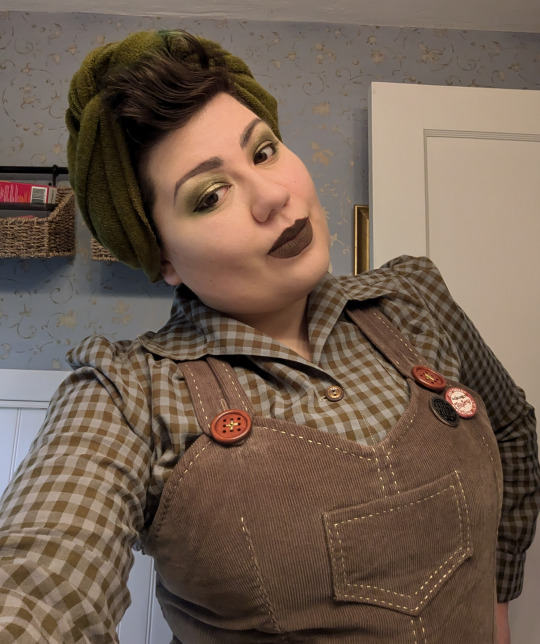
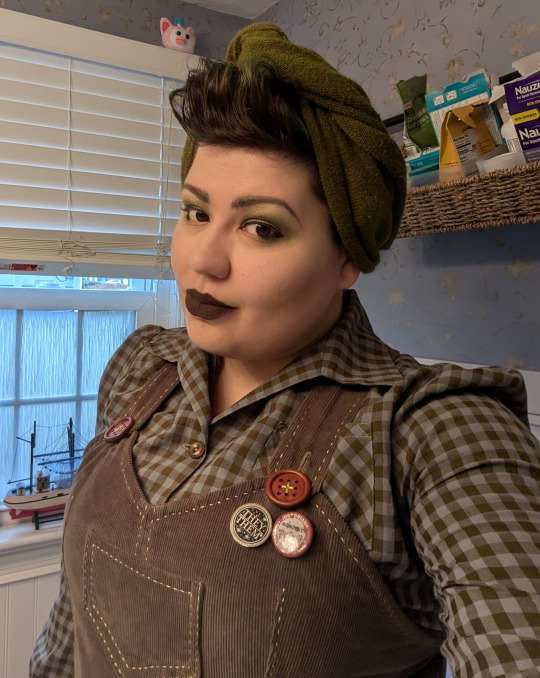

Weekends mean outings with the partner where we dress CUTE. Turban and blouse are from Freddies of Pinewood. Makeup is Notoriously Morbid. Overalls were made by me from Folkwear's Rosie the Riveter pattern.
47 notes
·
View notes
Text
At this point I've given up on pleading against the inevitable, if I'm gonna be part of history the least they can do is depict me in the most unenthusiastic, low spirit, "done with this bullshit", tired, character ever if historians ever take interest in my boring life
0 notes
Text
Intro Post for my new WIP, “Cantata.” If you haven’t yet read my completed IF, “Viatica,” you can find it here on itch.
Ko-Fi Link Here

A low fantasy IF loosely based on the Italian Renaissance period, with a steampunk edge.
DEMO on Itch
SYNOPSIS
The story is set in Saleste, an empire with a long history of expansionism and colonization. It is a vast, wealthy empire, very much set in notions of classism and noble privilege. And its warmongering has only grown more brazen under the current regis (monarch). Saleste is currently at a stalemate with Tinebaille, a neighboring island nation the empire has repeatedly tried, and failed, to conquer.
Within the empire, technically citizens but not, are the Iredicci. The Iredicci are as much a religion as they are a race—less like priests and more like monks or shamans. The Iredicci can hear and feel the cordis, the harmonic pulse that connects all living things, and they connect to it through song. Iredicci have excellent hearing, but their defining feature is their voice—they have an echo to their voice, a resonance of two pitches at once. The regis asked the Iredicci elders to use their unique gift to help him conquer Tinebaille, but as a peaceful people, they refused.
A simple, nomadic people, the Iredicci were traditionally welcome in all corners of the Saleste Empire. But as steam technology progressed and the push for new resources grew, a prejudice developed against them. The regis spread propaganda against the Iredicci, painting them as an inferior, uncivilized people who leeched off the empire rather than aided it. Over the years they stopped being welcome. Eventually, their travel was restricted, and the Iredicci were forced to live in settlement camps.
You are one of the Iredicci, born into such a camp. The elders sing songs of past travels and wonders you have never seen. Ever the optimists, the elders tell you to take heart. To be thankful you are among friends and family. That things can’t possibly get any worse.
Until they do.
Historians and politicians would call it The Proelium, a righteous battle against the traitorous Iredicci. What it really was, was the systematic genocide of your people. In one night, soldiers attacked every settlement camp across the empire. No one was spared—not the elders, not the children, not your mother.
It was mere whim that you snuck out of camp that evening, a mischievous escapade with a friend that ironically saved your life. You are taken in by your friend’s family and kept safe. But with survivors being hunted and killed, you must conceal your identity. So, you pretend to be deaf and mute.
Journey through the empire of Saleste and beyond. Grow from a child into an adult. Make friends, lovers, allies, and enemies. How will they react when your secret comes to light? Will you abandon your song in favor of machine? Join the rebel forces against the tyrant regis? Will you heal the wounds of the realm and restore balance? Or plunge it further into chaos?
FEATURES
Play as male, female or nonbinary—you’ll be able to choose your pronouns independent of your body type.
Customize your character’s appearance and personality.
Choose your attunement/proficiency with the cordis. This choice will heavily influence gameplay, affecting combat, weapon specialization, character interactions, and problem-solving situations. Choose wisely!
Create 2 character names: your birth name and an alias. The Iredicci have culturally unique names, so your birth name will be limited to a preset selection. But you will go by an alias of your own choosing for most of the story.
Develop your relationship with your adopted sister. Are you friends or rivals?
Romance! Or not. Romance 1 of 4 possible love interests, or choose the platonic route with the best of friends.
Save a wild animal from a hunter’s trap and gain a steadfast companion. Because fur baby.
THE MC
The game begins with you at age 7. When you are 12, your camp is slaughtered during The Proelium. With your voice and heightened hearing identifying you as Iredicci, you pretend to be deaf and mute in order to hide your heritage. The main game occurs 13 years after The Proelium, when you are 25.
ROMANCE OPTIONS
Calliope Cato (she/her)
The inventor/artificer, Calliope can build and fix any machine. She is 2 years younger than you, petite, with gold eyes, rich brown skin and black hair in multiple braids. Her hair and clothes are adorned in rings, belts, and pins which double as tools. She carries a man’s cane sword with her everywhere, which she wields in a fight along with a hand crossbow. She’s curious, optimistic, excitable, and easily distracted by her many projects, but much of that is to keep her mind occupied. In quiet moments when she thinks no one is looking, you glimpse a profound sadness on her features.
Corinne Xenakis (she/her)
The leader of the rebels, Corinne works to overthrow the monarchy and aid the surviving Iredicci where possible. She is 6 years older than you. She is tall, with long, sandy brown hair usually worn in a messy bun or loosely braided bun, hazel eyes, and beige skin tanned by the sun. Quiet, serious and aloof, she feels a tremendous responsibility for those under her command. Corinne is a contradiction—she has the grace and manners of a noblewoman, yet fights with military precision that is uncommon for females of noble lineage. She is deadly when double wielding her flintlocks or axes. While not cold, she is not overly familiar or friendly with anyone, and very tight-lipped about her past. What does she guard so fiercely behind her armor?
Vicente Aloi (he/they)
The bastard prince, Vicente is calculating, ruthless and driven. They are the same age as you, and they, too, lost their mother the night of The Proelium, though under different circumstances. But while you were adopted into a loving family, he is the unwanted son of the regis, trained to be a lethal tool. He has long, midnight blue-black hair, icy blue eyes, and high defined cheekbones. The edges of a tattoo are barely visible on his neck above the collar of his doublet… wings, perhaps? It’s beautiful. He’s beautiful, though you’d never tell him for fear he’d take his rapier to your neck simply for looking. Will your plans align with his, or are you merely another pawn in his schemes?
Bayram Durmaz (he/him)
The son of the Aydem, the matriarchal leader of Tinebaille. Bayram is 4 years older than you. He has golden-honey skin, light brown eyes, and dark brown, tightly-curled hair that he usually wears back in a ponytail or half ponytail. He is tall and broad, muscular but not toned, with a rounded edge to his stomach and chest. A sprawling, colorful tattoo, the mosaic artwork of his people, covers the entirety of his back. He is boisterous, bold, and a shameless flirt. With his young sister bearing the weight of succession, he’s been free to explore the islands to his heart’s content, and is familiar with every bay, inlet, and harbor. He is equally skilled at wielding a spear, sailing a ship, and charming hearts.
1K notes
·
View notes
Text

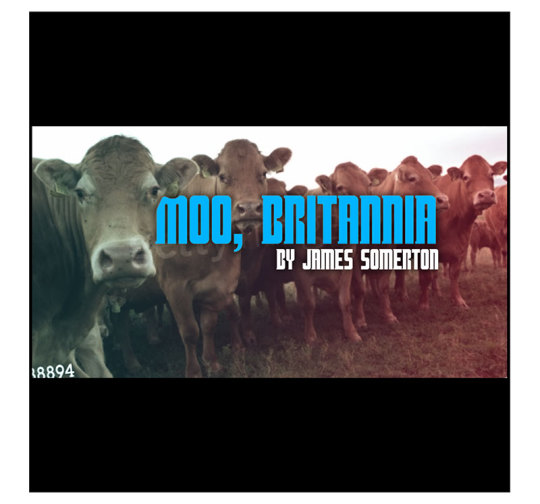
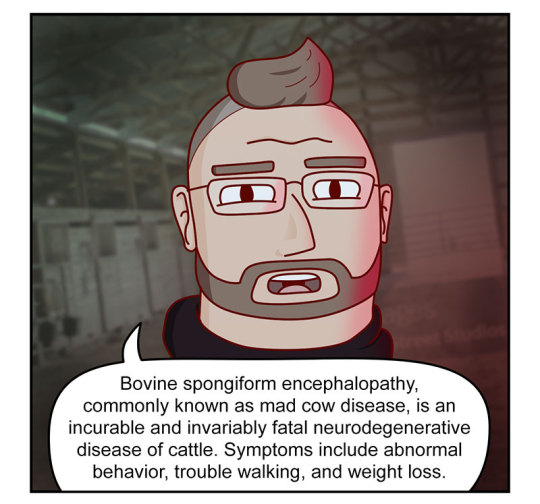
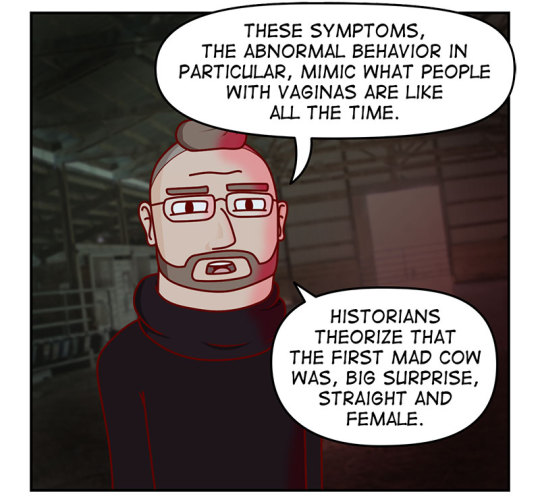
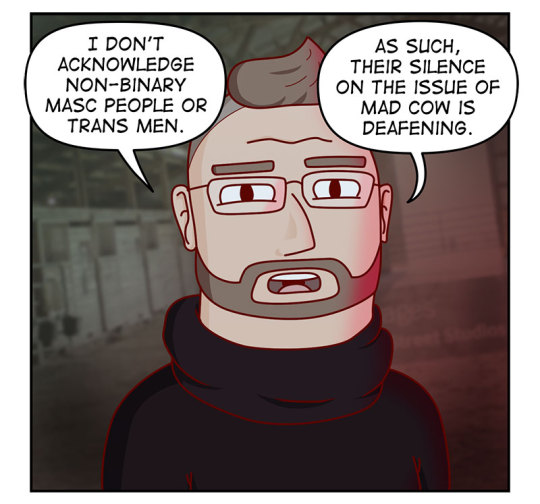
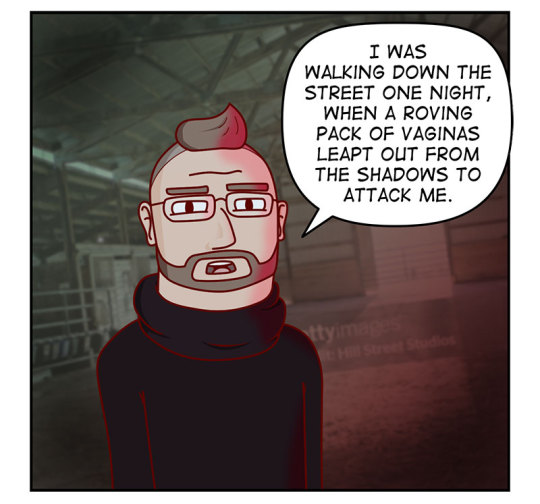


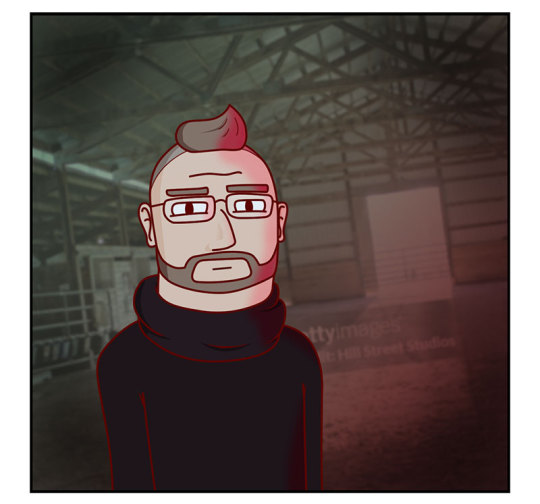

You may have seen a video on the internet recently. As have I!
A comic strip, Vampigeon by Josh Jennings.
Panel 1: Caption: It’s not all bad, James Somerton fans. Now that you know his formula, you can make an infinite number of his videos using only the power of your imagination
Panel 2: [A title card, with Stock Footage of cows with color filters and the text "Moo, Britannia by James Somerton."]
Panel 3: [YouTube Other People's Words Reader James Somerton presents a video.] James (Encyclopedia Text): Bovine spongiform encephalopathy (BSE), commonly known as mad cow disease, is an incurable and invariably fatal neurodegenerative disease of cattle. Symptoms include abnormal behavior, trouble walking, and weight loss.
Panel 4: James (Standard Dialogue): Historians theorize that the first Mad Cow was, big surprise, straight and female. These symptoms, the abnormal behavior in particular, mimic what people with vaginas are like all the time.
Panel 5: James (Standard Dialogue): I don't acknowledge nonbinary masc people or trans men, and, as such, their silence on the issue of Mad Cow…is deafening.
Panel 6: James (Standard Dialogue): Once, I was walking down the street at night, when a pack of roving vaginas attacked me.
Panel 7: James (Standard Dialogue): They brandished Mad Cow Burgers, screaming about I needed to kiss a boy in front of them.
Panel 8: James (Standard Dialogue): I managed to get into my home, but I could still hear the scraping of their claws against the glass. Hear their sickening howls, bragging about how women don't have problems.
Panel 9: [beat]
Panel 10: James (Encyclopedia Text): Currently the only reliable test for Mad Cow is examination of tissues during a necropsy citation needed.
789 notes
·
View notes
Text
Transmasculinity Throughout Time: Hatshepsut
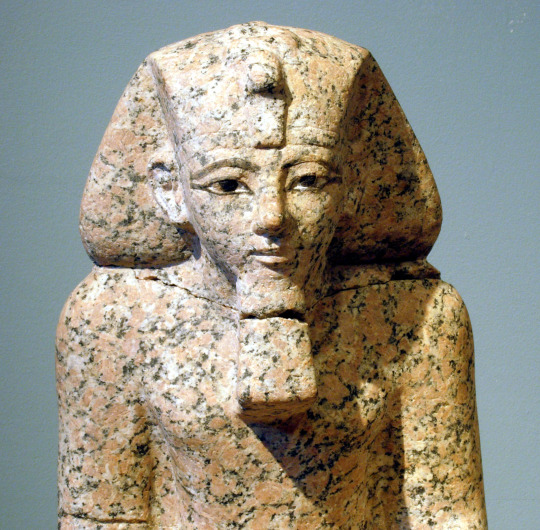
Kicking off this first post in what I hope to be a long series by saying that I am just a guy who likes obsessively researching things and I am absolutely not a historical expert, and in this case, not an Egyptologist. My perspectives and interpretations are my own. You are welcome to have other ones.
Hatshepsut is known as Egypt’s first and only female pharaoh, and is discussed as such throughout almost all material about them. I will be nonetheless using they/them pronouns to refer to them, but during their life they used both masculine and feminine pronouns. The tendency to project modern ideas onto historical figures is common. Especially in the case of people who exhibited signs of transmasculinity, it is common for their entire lives to be reduced to “women who cosplayed as men for power” which is problematic for obvious reasons. Cis men coveting masculinity for the pursuit of power in a patriarchal society is never a reason they are actually women, yet it is okay to do this with historical transmasculine people in the name of feminism? There is a clear double standard. So, I will be using gender neutral pronouns because we can’t really know if Hatshepsut was alive today whether they would identify as a woman, trans man, nonbinary or as none of those identities. I am simply going to be discussing the history and some of my interpretations.
In the context of ancient Egypt, the pharaoh was a living embodiment of the masculine god Horus. Hatshepsut embraced this role after coming to power, ascending from the position of queen regent alongside a child king once their former husband Thutmose II had passed, to “his majesty the king herself.” As their rule progressed, they were depicted as more and more masculine in statues and reliefs, using the same ceremonial fake beard as male pharaohs, muscles, and other masculine signifiers. They didn’t stop wearing makeup and jewelry when presenting as a male king though, which some historians take as evidence to support a female gender identity - it could mean that, but it could also just mean they liked to be fashionable and didn’t subscribe to restrictive gender roles!
Like kings before them, Hatshepsut emphasized their connection to the gods by telling a story to justify their rule. However, the story they told had to be exceptional - and it was. Hatshepsut’s throne name, Maatkare, translated to “truth is the soul of the sun god.” This demonstrated a connection to the sun god, Amun or Ra, and to Maat, the tradition of maintaining harmony in ancient Egypt. The story was that Amun had appeared to their mother who had conceived Hatshepsut for the purpose of being king, commanded by the god of creation Khnum, to “fashion [them] better than all gods” with “the great dignity of a king.” In carvings, Khnum created Hatshepsut as a little boy. This explanation for their lineage is especially interesting because it emphasizes their connection both to their mother’s bloodlines and to being the child of Amun, not ruling as just a queen regent, but as a king.
During their rule of 20 years, Egypt’s trade flourished and there was an immense period of construction during which countless buildings and statues were created, and temples renovated. Unfortunately after their death, extreme measures were taken by Thutmose III to erase all records of Hatshepsut from existence in order to preserve the line of male kings. These efforts were primarily successful, and much of their history has been lost to time. There are many things about Hatshepsut that we will never know.
#transmasculinity throughout time#transandrophobia#transmisandry#antitransmasculinity#transmasculine experiences#trans men#transmasc#hatshepsut#ancient egypt
160 notes
·
View notes
Text
Trans Terror Week 2024
We’re back! Trans Terror Week 2024 will run November 24-30th.
Between Twitter dying and busy mods (@solomontoaster and @manicpixiedreamjop once again), we are not going to have much of a presence on Twitter this year, though we will be keeping tabs on it. Your best chance at getting a quick response will be one Tumblr!
The rules are the same a last year, detailed on our FAQ page (for the mobile accessible FAQ go here).
Rules and Reminders:
This event is for anyone who is trans, nonbinary or is currently questioning their gender. Our goal is to uplift trans content creators in the Terror fandom and we encourage cis creators to show their support for their trans compatriots.
There is NO restriction on type of content: art, fics, edits, playlists, videos, everything is welcome!
November 24th is also for Creator Spotlights, make a post highlighting your works and we’ll give you a boost!
Please tag your works #transterrorweek/#transterrorweek2024 and/or ping us @transterrorweek to make sure we see your stuff! This applies to both Tumblr and Twitter.
Fics can also be added to the Ao3 collection. Simply search for “Trans Terror Week” when posting your fic or follow the link on our blog. Our FAQ has instructions for posting anonymously.
Prompts:
This years prompts are the result of three semesters of grad school study and research on the part of one of the mods. As always, full details on the prompts can be found on our prompts page:
Day 1: Staged Otherness | Trans Performers - Fanny & Stella
Fanny & Stella cross dressed both onstage and in their personal lives during the 19th century.
Day 2: Kabloona |Trans Explorers - Jan Morris
Jan Morris was the first* trans person to ascend Mount Everest as a journalist accompanying the 1953 British Mount Everest Expedition. *as far as I know
Day 3: "Herodotus and Oral History" | Trans Historians - Leslie Feinberg
Leslie Feinberg is the author of the pioneering trans history text Transgender Warriors.
Day 4: "Identification of a Senior Officer" | Trans Military Officers - Chevalière d'Éon
Charlotte d'Éon de Beaumont, the Chevalière d'Éon, was recognized as a woman by King Louis XVI, who furnished her with a new wardrobe.
Day 5: "Learning About Sea Ice" | Trans Scientists - Alan L. Hart
Alan L. Hart pioneered the use of x-ray photography for tuberculosis diagnosis.
Day 6: Arctic Circles and Imperial Knowledge | Trans Titlebearers - Sir Ewan Forbes
Sir Ewan Forbes of Craigievar was the 11th Baronet of his family’s barony from 1968 until his death in 1991.
Day 7: "You Do Not Belong Here" | Trans Activists - Loren Cameron
Loren Cameron was a trans activist and photographer, known for photographing nude trans bodies.
83 notes
·
View notes
Note
personally I would love a poll for hot vintage actors/celebrities who played with gender and androgyny or were outright trans/nonbinary, but I'm not sure how many there are or how much time you have to dedicate to the polls so I'll throw it out there for any followers who want to start their own poll
I thought about doing this, but it would be an impossible poll to run fairly for a couple of reasons. (I'm going to be using the word "queer" here as a catch-all term for trans/nb/gender-nonconforming presentation, in the hope that we all understand I'm using it in the reclaimed sense.)
For one thing, being queer was so heavily silenced, punished, and/or criminalized we can't say with any certainty which hotties were trans/nb/questioning. It's possible many of these hot vintage performers would have come out if it had been safe to do so, but we can't tell from this distance. I would hate to exclude anyone just because they don't read as queer "enough" to my eyes, when for them they were just busy surviving.
The other thing is that even as recently as the vintage era of these polls, queerness sat a little differently than it does today. Just as modern historians can't project current systems of gender on figures from the past, I would feel uncomfortable assuming that someone might be trans/nonbinary/gender nonconforming just because they would be read that way today. There's been a lot of cultural shift over the last 100 years where certain things that used to be considered very radical and genderqueer are now utterly normal (ie, women wearing pants) and other things that now read as queer would not have raised an eyebrow then (ie, the oft-quoted article from 1918 that posits that pink is a boys' color, or the entirety of the classic Wings).
In a way, this is freeing—watching vintage movies shows many different ways of framing gender and sexuality, and while some of it is the kind of dated binary we expect, some of it is like light pouring through a window. There are many different ways of framing a gender! The whole concept of gender is moveable and transient! Queerness is as much a part of human nature as love, and teeth, and bones, and touch! But because it was a different era, and because the secrecy prevalent at the time doesn't fully let us know who was or wasn't part of the community, we can't really say for sure (without a lot of extra research, and lots of very careful framing) who was doing things with gender we would today translate as trans, nonbinary, or queer.
Hope this makes sense!
#asks#i hope this comes through w/ the respect for vintage trans nb people i intend. i just don't think it's our right to pry or rank#(as a bracket inevitably does) in a case as tender as this.#happy to talk more if some of my ideas or references don't make sense!#queer vintage#lgbtq+
264 notes
·
View notes
Text
The Invisible Truth' Au Characters (Part 4);
Antonio's kids (Part 2):

Dayana Noemí Espinosa Madrigal (8 years old by d3. Student at the Encanto’s only public school and she helps José run the casino out of his room along with Avila—she has a few ideas on what she'd like to do when she grows up, including: a private inspector, a theme park performer or owner, archeology, and a historian are just a few of them. Clever, graceful, detail-oriented, fair, hardworking, cautious, business minded, firm, secretive, sneaky, reserved, curious/inquisitive, analytical, passionate, patient, helpful, aspiring, osscasionally very blunt, and caring. She has the gift of ‘monster sight’ meaning that she can see monsters that no one else can. She is single and is friends with her brother, her cousins, their partners, and Blue Veronica).
Next Gen Love Interests;

Araceli Peña Merlo (28 years old by d3. English Teacher at the Encanto's only public school and granddaughter of one of the Encanto's Original founders. Kind with a mighty backbone, empathic, graceful, knowledgeable, inquisitive, helpful, respectful, professional, motivating, courageous, idealistic, supportive, creative, non-judgmental, inspiring, dedicated, passionate, and headstrong. She doesn’t have any powers or a gift. She's currently dating Cesare Madrigal Botero and she's friends with her fellow teachers, Carina Potts, Shepherd Scaremonger, Eliza Fae, Jim ‘JJ’ Brown Jr, Hunter de Vil, and Horace the Auradon Prep Librarian).

Simon Cantor Acosta Cova (24 years old by d3. He's the owner of ‘Simon’s Western Experience’—a shop that sells things relating to cowboys and horses—and He's the grandson of Heidi from the “Nightmares and Sueños” book. Intelligent, flirty, mischievous, upbeat, resourceful, eccentric, brave, sneaky, impulsive, selfless, easygoing, and occasionally inconsiderate and jerkish. He doesn't have any powers or a gift. He's dating Cornel Madrigal Botero and he's friends with Horace the Auradon Prep Librarian, Jane Darling, Carina Potts, Princess Melody, Amore Pugliese, Shepherd Scaremonger, and Araceli Peña Merlo).

Amore Pugliese (27 years old by d3. Nonbinary Sea Monster from Genoa, Italy, and the owner of ‘Amore’s Fabric Stop and Shop’. Adventurous, mischievous, bubbly, rebellious, artistic/creative, adaptable, free spirited, energetic, snarky, loud, bombastic, determined, sarcastic, supportive, comfortable and confident in themselves and who they are, open, open-minded, playful, attentive, and unapologetically authentic. They have the powers of human transformation and Aquatic Breathing. They are engaged to Cyriacus Madrigal Botero and are friends with Ivy de Vil, Eliza Fae, JJ Brown, most of the Guzmáns and Madrigals, Araceli Peña Merlo, and Simon Cantor Acosta Cova).

Madeline ‘Mad Maddy’ Meraxes Mim (21 years old by d3. Member of Harriet Hook’s crew—The Queen’s Fury—and bassist of The Bad Apples, one of the first former students of 'Madam Mim's School of Magic’, and worker at Madam Mim’s Wicked Witchcraft Emporium. If she had the chance, she’d like to be an astronomer. Granddaughter of Madam Mim. Deceitful towards those she doesn’t like, temperamental, vengeful, bitter, impulsive, driven, witty, sneaky, talented, ambitious, snarky, cynical, troubled, unforgiving, protective, loyal, moody/apathetic, snippy, risk taking, and guarded. She has magic and is fantastic at potion brewing. Crushing on Rick Madrigal Botero and friends with the Madrigals, their partners, some of her siblings, some of her cousins, Lefou Deux’s family, Homicide Le Fay, Blaise Le Fay, Kai Athanasiou, Ula Athanasiou, Uziel Athanasiou, Arabella Athanasiou, and Harriet Hook's crew).

LeFou Deux ‘Lee’ Beaumont-LePrince (19 years old by d3. Member of Harriet Hook's crew, The Isle Santa, and worker at Cipriano Guzmán’s Toy Shop. Former worker at Hook's Inlet and Shack, Hook’s Clock & Curiosity Shop, Gaston's Pub, and Gaston’s duels without rules. He’s happy with the job he has. Son of Stanley, LeFou, and Paulette. Shy, sweet, helpful, skittish, quiet, clumsy, poetic, stubborn, hardworking, sneaky, patient, intelligent, friendly, awkward, protective, mischievous, and giving. He doesn't have any powers but he is quite good at inventing and fixing things. He is friends with the Madrigals, their partners, his siblings, his cousins, Homicide Le Fay, Blaise Le Fay, Kai Athanasiou, Ula Athanasiou, Uziel Athanasiou, Cipriano Guzmán, and Harriet Hook's crew).

Vidal Alfaro Pezmuerto (17 years old by d3. Student at Auradon Prep and Member of the R.O.A.R/Swords and Shields Team as well as the Fútbal —he wants to either be a marine biologist or be a pro R.O.A.R player. Son of Señora Pezmuerto and Luca Alfaro. Quiet but usually extroverted, easily embarrassed, athletic, skeptical, cautious towards things that could lead to embarrassment, judgemental, respectful of others boundaries, stubborn, hardworking, playful, sneaky, Unafraid of danger, Impulsive, and proud. He doesn't have any powers. He is friends with Harlan Alan Never, Portabella Neverwing, Felicidad Ruíz, ichabod ‘Icey’ White, Princess Natasha, Demurra Foxworth, Rolando Ortiz, and Rebecca of Rosas).

Lin 'Gizmo' Mazorra (19 years old by d3. Worker at Miracle Tech, the Encanto’s first and possibly only tech shop—he wants to be either a musician or a Cinematographer that specializes in music videos. Formerly Homeschooled and the son of Dary Mazorra, the owner and founder of Miracle Tech. Introverted, awkward, quiet, insecure, creative, imaginative, goal oriented, focused, intelligent regarding tech related things, musically attuned, hardworking, helpful, passionate, loyal, sensitive, and soft spoken. He doesn't have a gift or any powers. He has Tourette's syndrome. He is dating Elmira Guzmán Madrigal and is friends with the Madrigals, Théotime Cogsworth, Bobby Hood, Tiger Peony, William Darling, and Portabella Neverwing).

Portabella Neverwing (15 years old by d3. Transfer student from Neverland Academy to Auradon Prep who wants to be an activist when she grows up. Daughter of Egidius and Bluebell. Creative, stubborn, extroverted, loud, goal oriented, empathic, hardworking, helpful, passionate, loyal, protective, rebellious, sour then sweet, free spirited, and seemingly care-free until angered by something that is unjust. She can fly and she is a garden talent fairy with powers that tie into nature. She is dating Emilia Nattura Madrigal and she is friends with Tiger Peony Rossi, Anxelin Fitzherbert, Bobby Hood, William Darling, Théotime Cogsworth, and Lin 'Gizmo' Mazorra— she very notably does not like Unity and Hap Bergmann, Annabelle Scorfano, or the Bluefairy-Carmelo twins, and has a frenemy relationship with Stella Rabbit who is on thin ice with her).

Cailee Beckett (16 years old by d3. Student at Dragon Hall, Member of the Sea Ponies and Anti-Heroes Club, and occasional worker at Lady Tremaine’s Curl Up & Dye—she wants to be a firefighter, artist, or a famous Auratuber when she grows up. Preferably one that works with Gigi. She is the daughter of Cutler Beckett and an unknown woman. Funny, extroverted, loud, loyal, empathic, playful, creative, patient, graceful, courageous, sweet, care free, non-conforming, and mostly well-behaved. She doesn't have any powers or gifts. She is dating Magnolia ‘Gigi’ Marguerite Gothel and she is friends with Murky Maggie, Amara Tremaine, Julieanna 'Julie' Foulfellow, Sabina Stromboli, Dizzy Tremaine, Owena, Elizabeth 'Lizard' West, Sad Sally Mim, and she's slowly becoming friends with the Madrigals as well).

Théotime ‘Time’ Cogsworth (16 years old by d3. Student at Auradon Prep and Member of the Film Club and the Robotics Club—he wants to be a film director when he grows up. He is the son of Cogsworth. Rebellious, intellectual, reserved, bit of a loner but can be social around people he likes, free spirited, non-conforming, kind, open minded, curious, peaceful, a wee bit resentful, well organized, passionate, dependable, loyal, and dedicated. He doesn't have any gifts or powers. He is deaf/hard-of-hearing, has heterochromia, and has a lip piercing, multiple ear piercings, and a nose ring as well as glasses. He is dating Oscar Guzmán Madrigal and is friends with the Madrigals, most of the film and robotics club members—including Doug Bergmann, Anxelin Fitzherbert, Portabella Neverwing, Prince Diego of Cordoba, Elle Athanasiou of Tirulia, Princess Avisa Athanasiou of Atlantica, Arabella Athanasiou of Tirulia, Zhu Yi-Min, and Jedoun 'Jordan' Ayad).

Prince Diego of Cordoba (15—almost 16—years old by d3. Student at Auradon Prep, School Contraband Smuggler and Seller, and Member of the Art Club—he wants to be a graphic novelist that specializes in horror and detective stories. He is the son of Prince Alonso of Cordoba. Reserved, sweet, friendly, even tempered, insecure, curious, creative, protective, sullen, imaginative, giving, cautious, hardworking when motivated, optimistic, loyal, patient, strong, well behaved but a rule breaker, odd/strange/creepy, and wouldn't hurt a fly unless provoked. He doesn't have any gifts or powers. He is in tutoring and extra help classes due to his struggles in a usual class environment. He is seen as a dimwitted slacker by many because of this. He is dating Sofia Madrigal Prepon and he is friends with Théotime ‘Time’ Cogsworth, Lin 'Gizmo' Mazorra, Portabella Neverwing, Anxelin Fitzherbert, Arabella Athanasiou of Tirulia, Crabby Bergmann, Doug Bergmann, Sleepy Bergmann Jr, and Baren Hood).

Haruto of Avalor (19 years old by d3. Model for Evie's 4 Hearts and Cheerleader and Student at Sherwood University—he wants to be an actor. Son of Tomiko of Avalor. Confident, hard working, romantic, focused, hard working, proud, spirited, adaptable, determined, athletic, patient, gossipy, fashionable, dedicated, judgemental, loyal, smart alec, protective to his people, great team player, and a multi-talented overachiever. He doesn't have any gifts or powers. He is dating Princesa Guzmán Madrigal and is friends with the rest of the cheerleading team, the tourney team, some of the band kids, some of the choir kids, some of the art club kids, the R.O.A.R kids, Princess Avisa Athanasiou of Atlantica, Chao, Kelemon Ceinfarfog Of Northumberland, Blair of DunBroch, Nora Nattura, Hilda Bjorgman, and Catharina ‘Cato’ Bones. Doesn't know the Madrigals that well yet).

Ronaldo Ortiz (16 years old by d3. Student at Auradon Prep and Member of the Debate Team and Tutoring Club—doesn’t know what he wants to do with his life yet. Does know he doesn't want to work in his father's field. Son of Osvaldo Ortiz. Hard working, smart, kind, focused, determined, very patient, easily embarrassed, dedicated, snarky when he's pushed, resentful, thoughtful, cautious/careful, and a bit of an overachiever. He doesn't have any gifts or powers. He is dating Rachel Madrigal Botero and is friends with Vidal Alfaro Pezmuerto, Felicidad Ruíz, Becca Colyar, Topher Thompson, Prince Diego of Cordoba, Théotime ‘Time’ Cogsworth, and Rosana Cardoso).

Christopher ‘Topher’ Thompson (18 years old by d3. Student at Auradon Prep and Member of the Auradon Prep Marching Band—wants to open a seaside restaurant on a boat where he can play music: he's workshopping the name. He is the secret great nephew of Smee. Secretive, open minded, somewhat lazy, thoughtful, cautious, playful, brave when it counts, patient, resilient, fun loving, adventurous, fun loving, creative, curious, attentive, and cuddly. He doesn't have any gifts or powers. He is dating Zoey Marquez Madrigal and is friends with Ben, Doug, the choir kids, the band kids, some of the tourney kids, a couple of the cheerleaders, and some of the Madrigals—he’s trying to win over the rest of them).

Becca Colyar (16 years old by d3. Student at Auradon Prep and Member of the Cheerleading Squad—wants to be a professional dancer when she grows up. She is the daughter of Buford the Chef. Hyperactive, fun loving, easily excitable, sly, unpredictable, athletic, hardworking, occasionally impatient, reliable, strange, friendly, playful, blunt, adventurous, creative, thoughtful, dedicated, popular, funny, determined, respectful, focused, good listener, a total fangirl, and a bit team player. She doesn't have any gifts or powers. She is dating Miguel Marquez Madrigal Jr. and is friends with the rest of the Cheerleading squad, a couple of the band kids, Tyrone Rogers, Nina Rogers, Princess Avisa Athanasiou of Atlantica, Chao, Kelemon Ceinfarfog Of Northumberland, Blair of DunBroch, Nora Nattura, Hilda Bjorgman, Princess Elle Athanasiou of Tirulia, Catharina ‘Cato’ Bones, and a pair of sisters named Mary and Dorothy).

Felicidad Ruíz (15 years old by d3. Student at Auradon Prep and Former member of band, choir, and acapella—she’s close to resorting to making her own club at this point because as someone who plans to be a musician she refuses to stand for how few choices there are. She plans to start her own band or maybe join one of the Madrigal’s bands. She is the daughter of accordion player Alejo Ruíz. Caring, protective, opinionated, musically inclined, stubborn, cocky, passionate, talented, picky, judgemental, rebellious, persevering, non-conforming, fun loving, lazy when unmotivated/uninterested, occasionally dismissive, somewhat unreliable depending on who you are, creative, determined, dedicated, open minded, rule following to the extent that people don’t always realize she doesn’t respect them/don’t notice the rest of her personality, sneaky, and under the firm belief that respect is earned, not freely given on principle of authority. She doesn't have any gifts or powers. She is dating Fuega Alba Guzmán Madrigal and is friends with Mal, Ben, Evie, Doug, Portabella Neverwing, Freddie Facilier, Ally Liddell, Rosana Cardoso, Prince Ajax, Arabella Athanasiou, Anxelin Fitzherbert, Yi-Min, Marlon of DunBroch, Hodge Westergaard-La Bouff, Herkie Athanasiou, Icey White, Elle Athanasiou, Avisa Athanasiou, Annika and Raylene Jenkins, Théotime Cogsworth, and several of the band, choir, and acapella kids).

Rosana Cardoso (15 years old by d3. Student at the Encanto’s only public school and Member of the Choir and the outdoors club—she wants to be a home economics teacher, a seamstress, a fashion designer, or a mixture of the three if possible. Daughter of Encanto farmers. Preppy, cheerful, sweet, outwardly respectful, humbling, a tad bit cliquish, girly, helpful, sneaky, good at reading people, friendly enough, even tempered, restrained, protective, distinguished, fashionable, isn’t afraid to get her hands dirty, graceful, optimistic, mostly conflict avoidant, affectionate, patient, curious, resourceful, calculating when required, creative, true to herself, semi-popular, and soothing with a rebellious side most don’t know about—she gives the perfect girl next door vibes. She doesn’t have any gifts or powers. She is dating Amelia Madrigal Prepon and is friends with the Madrigals as well as several people inside of the Encanto and out—but she’s noticeably close with the other farmer kids, Théotime Cogsworth, Felicidad Ruíz, Becca Colyar, Portabella Wings, Topher Thompson, Lin 'Gizmo' Mazorra, Prince Diego of Cordoba, Vidal Alfaro Pezmuerto, Cailee Beckett, Ronaldo Ortiz, and Haruto of Avalor. She also very noticeably hates Annabelle Scorfano and helped Amelia get revenge on Sofia’s former friends in the Encanto instead of soothing her temper as she usually would).

Annabelle Mijares Marcovaldo Scorfano (15 years old by d3. Student at Auradon Prep and Member of the Swim Team—she wants to go to the Olympics or be a model/actress. Daughter of Alberto Marcovaldo Scorfano. Grateful, oblivious, sneaky, deceitful, street smart, manipulative, cruel at times, lazy, selfish, prideful, fun-loving, pouty, expressive, secretive, judgemental, helpful when needed, shameless, and gregarious. She can shapeshift and breathe underwater. Tito Nattura Madrigal has a crush on her that is kind of requited. She is friends with Scarlet Bluefairy-Carmelo, Dragonet, Carter Bluefairy-Carmelo, Hugo Madrigal Prepon, Princess Roanne, Princess Mia Westergaard-La Bouff, Hap Bergmann, Unity Bergmann, Stella Rabbit, Demurra Foxworth, and Ariana Rose).

Wickley ‘Wick’ Wing (13 years old by d3. Transfer student from Neverland Academy to Auradon Prep during d3, former member of the Neverland Academy Cheer Team, and a fast flying talent fairy—he wants to be an amusement park worker or a zoologist when he grows up. Son of Trak the scouting fairy and Tizzywing the fast flying fairy. Mischievous, playful, fast on his feet, compassionate, passionate, brave, reckless, graceful most of the time, talented, friendly, impulsive, occasionally rude, fun loving, snarky, helpful, caring, sneaky, street smart, ditzy, and protective. He can fly and change his size. He has a crush on Belinda Nattura Madrigal and she has a crush on him. He is friends with Carlos Madrigal Prepon, Hugo Madrigal Prepon, Leta Guzmán, Tulip Rossi, Danny Darling, Portabella Neverwing, Eleanor Bluefairy-Carmelo, Pino ‘Pin’ Collodi-Rossi-Liddell, and Evenstar Cricket).

Eleanor Bluefairy-Carmelo of Llyr (14 years old by d3. Student at Auradon Prep and Member of Belle’s Book Club and the Art Club—she wants to be a famous artist when she grows up. She is the daughter of Alexander Bluefairy-Carmelo and Princess Eilonwy of Llyr. Modest, imaginative, mindful, a little stuffy, smart, dutiful, sneaky/secretive/deceptive, classy, stubborn, mischievous when no one is around to see, nerdy, introverted, and is oftentimes considered the ‘well-behaved’ one. She can fly and she has magic that she is currently practicing. Shs is dating Carlos Madrigal Prepon and is friends with Tulip Rossi, Pino ‘Pin’ Collodi-Rossi-Liddell, Wickley ‘Wick’ Wing, Marcelo Rivera Madrigal, Portabella Neverwing, Ligera Guzman Madrigal, and Artorius 'Artie' Pendragon).
Random Encanto Oc Extras:
Band members:

Alejo Ruíz, father of Felicidad Ruíz.
Buenavista Bové, cousin of Sheyla and Cecilia Bové.
Sol Velasquez, grandfather of Juancho and Reynaldo Velasquez.
The (former) town kids:

Rio Gracia, Juancho Velasquez, Ignacio Gracia, Cecilia Bové, Mirabel Madrigal, Alejandra Isvandi, Alonso Arias, and Sheyla Bové.
Farmer:

Rendon Abraham Cerebro de Burro. He has three children—named Cimarron, Enrique, and Ana Cerebro de Burro.
Bartender/Bar Owner and Tech Guy:
Heidi Cova. Owner of the Encanto’s first (and possibly only) bar, Paraíso Fabricado.
Dary Mazorra. Owner of the Encanto’s first tech shop, Miracle Tech. Father of Lin ‘Gizmo’ Mazorra.
------------------------------------------------------------
Picrew links: Wervty Profile, Luca, Baydews, Cowboy Picrew, Cowgirl Doll Divine maker, Fairy Meiker.io maker, Fairy Picrew 2 , ummmmandy, third fairy picrew, and chemicataclysm . Thanks to @igetthedisneybox for letting me use her ocs, Rosana and Felicidad, and for all the help she lent me in the creation of these ocs. Thanks to @bellalampwickrossi for allowing me to use Eleanor. And thanks to @fairiesandbeatleslover for allowing me to make Portabella based off of their oc, Egidius. The rest are background extras in the descendants movies and ocs based off of concept art.
#descendants#disney descendants#melissa de la cruz#disney#descendants au#wicked world#disney descendants au#the madrigals#the madrigal family#encanto next gen#encanto#encanto ocs#encanto next generation#original characters#encanto concept art#invisible truth au#the invisible truth#invisible truth#etc
37 notes
·
View notes
Text
RippleClan: Moon 88
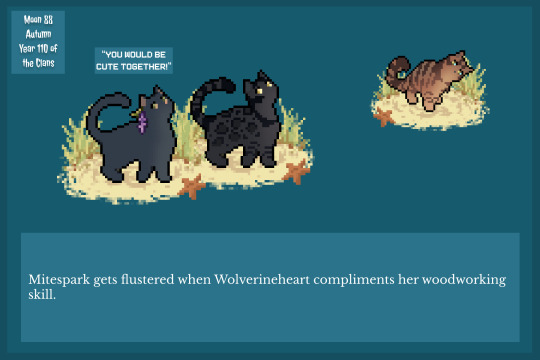
Mitespark gets flustered when Wolverineheart compliments her woodworking skill.
[Image ID: Ravenweaver and Mitespark watch Wolverineheart go. Ravenweaver says, "You would be cute together!"]
(Ravenweaver: 23, female, artisan, nervous, den builder, very clever)
(Mitespark: 30, female, artisan, charismatic, great mediator)
(Wolverineheart: 20, female, warrior, troublesome, student of science)

Despite an awkward assessment, Shrewpaw recovers from his bruises and is named Shrewflame for his fierce confidence. Thundergale considers herself lucky to have mentored such a great cat.
[Image ID: Shrewflame is now an adult! Under him, it reads LEVEL UP! SHREWPAW → SHREWFLAME, COMPETITIVE → LOYAL, NEVER SITS STILL → FAST AS THE WIND. Thundergale watches proudly in the back.]
(Shrewflame: 12, male, teacher, loyal, fast as the wind)
(Thundergale: 20, female, teacher, adventurous, good hunter, good speaker)

Halibutdusk is worried about the storm overhead, but continues on their date with Clammask anyway. As they walk along the river, a flash flood overcomes them. Halibutdusk clings to the stepping stones, but Clammask is washed to sea.
[Image ID: Halibutdusk and Clammask wander under a cloudy sky, where the ghosts of Twinekit, Locustseeker, Burdockcreek, and Rustshade watch and wait.]
(Halibutdusk: 80, nonbinary (they/them), warrior, gloomy, masterful storyteller, clever)
(Clammask: 82, female, caretaker, righteous, lore master, good teacher)
(Rustshade: 102, male, codekeeper, sneaky, learner of lore)
(Burdockcreek: 40, male, historian, competitive, lore keeper)
(Locustseeker: 12, nonbinary (they/them), historian apprentice, troublesome, moss-ball hunter)
(Twinekit: 2, female, kit, noisy, quick to help)

Wildclaw and Honeybuzz grieve. Honeybuzz wonders how Stormjump is doing.
[Image ID: Wildclaw talks to her littermate, with + CONDITION: GRIEVING under her. On the other side, Stormjump speaks with Downstar and Carnationspeckle. Honeybuzz watches them both, + CONDITION: GRIEVING written under him.]
---
Stars damn it all.
Honeybuzz knew it was natural for a kit to sit vigil for their parents as the latter grew old and their fur turned gray, but Honeybuzz still felt too young to lose Clammask too. And this time, there was no clear culprit he could blame. Halibutdusk wasn't like Rapidleaf, they didn't shove Clammask into the water, and they didn't run from whatever role they played in Clammask's death either. They even offered their freedom up to Venturedapple and Cobaltchaser, willing to sit through a trial and sort out the details of the incident. Not that the outcome wasn't clear, though; this was no living cat's fault. Perhaps Clammask's littermates decided to call her home. Perhaps the All-Seeing prevented any warnings from reaching the clerics' ears so their grand plan could unfold.
Whoever decided Clammask would die that day, stars damn them.
At least the Clan had a body to sit vigil for. While on patrol, hoping that Clammask found her way back to shore, Rapidleaf, Asterblaze, and Tallowheart found Clammask's body drifting along the edge of the beach. Troutpool and Oilstripe mournfully reported Clammask's spirit escorting the body to camp before departing with Twinekit, Locustseeker, and Burdockcreek. Weevilsight and Carnationspeckle dried her body and made sure she looked her best. The last child of RippleClan's first litter, departed for the stars.
Honeybuzz muttered along to Troutpool and Estherfern's ritual as he, Splashtuft, Leathermask, and Drumtooth pressed their noses into their mother's pelt one last time. To the side, Wildclaw and Halibutdusk leaned into each other, each bearing the other's grief on their backs. A long pelt covered Halibutdusk, fighting off the chill of the autumn water. Yet Honeybuzz was the one who couldn't stop shivering. Stormjump, Carnationspeckle, and Downstar built a large fire to the side of the vigil—a dash of warmth to send Clammask up to Silverpelt. It did not calm Honeybuzz's body.
Vervaincough, Potterypool, and Moontide curled up along Clammask's back. Vervaincough's breath itched at Honeybuzz's neck. Neither Clammask's sons nor her daughters wanted to be the first to leave their mother behind and embrace the night that had slowly enveloped them over the course of the vigil. Yet when Honeybuzz dared look up from Clammask's still-damp fur, he could see Oilstripe, Mosspounce, and Slushtrail patiently waiting for their turn to mourn. Honeybuzz kneaded his mother's still belly. Could he really leave her behind? Would he see her the next time he visited StarClan's Shrine? Whatever the case, Honeybuzz couldn't stay with his siblings forever. Clammask wasn't just important to them.
Honeybuzz pried himself away from Clammask's body with a pitiful moan. His cicada wing necklace left an imprint in her fur. His paws mindlessly carried him away, leaving room for Oilstripe to mourn her little sister.
"Honeybuzz, wait," Leathermask whined, lifting his head from the vigil.
"Let him go, Leather," Splashtuft sighed. "I… I think I need to leave, too." Splashtuft shoved himself up and hurried to the warrior's den. Billowhaze and Tallowheart, who quietly shared tongues outside the den, followed their fellow historian in, ready to offer whatever comfort they could manage.
"I'm not leaving," Drumtooth promised, pressing closer to Leathermask as Mosspounce found his opening to mourn.
Honeybuzz wandered toward Stormjump and the growing fire. He had no real agenda, no idea what he needed, but in the bottom of his heart, he knew Stormjump could provide it. Stormjump, to her credit, was the first to notice Honeybuzz's approach. She set a piece of kindling to the side of the flames and turned to see who joined her, Carnationspeckle, and Downstar in their work.
"Honeybuzz," Stormjump cooed. "Come warm up. You look wet." Stormjump moved aside so Honeybuzz could creep closer to the fire. His shivering eased as Carnationspeckle gently groomed his fur the wrong way.
"What do you need, Honeybuzz?" Downstar asked.
"You tell me," Honeybuzz scoffed, resting his head on the warm sand.
"It's late, but we could prepare a simple stew," Carnationspeckle suggested. "Something with heart-healing herbs to warm our bones."
"The Clan already had their evening meal," Honeybuzz sighed. "Don't waste food for the sunhigh meal."
"Take it from an older cat, Honeybuzz," Downstar sighed, eyes trailing to Clammask's body. "A loss like this is going to hurt, and you won't be the same cat you were this morning. But eventually the good memories will pad around that loss, dampen the sound of the grief. It'll be there, and it will still hurt. But you'll have more and more joy to draw strength from, if you allow yourself to hold onto it." Carnationspeckle licked her former mentor's shoulder and rested her chin on her back. Honeybuzz just closed his eyes. That little speech seemed more for Downstar than for him.
He never told her. Honeybuzz never told Clammask the truth about Scrubmask and Rapidleaf. She knew now, finally reunited with her first mate. She knew about Honeybuzz's silence. Did she understand his intentions? Did she see the chaos the truth would bring? Or did she only see her son, the liar, the secret keeper, the cat who let a killer share the same den as his brothers and sisters without so much as a meow of protest?
"It's alright to cry, Honeybuzz," Stormjump sighed, nuzzling Honeybuzz's neck. Honeybuzz didn't realize his breath had begun to hitch. "Maybe you should get some sleep. Want me to walk you to the medicine den?" Honeybuzz swallowed hard and nodded. He forced himself up, but this time, Stormjump was there, leaning against Honeybuzz, catching his weight. The pair sank into the sand. Honeybuzz didn't care to wipe it off his paws when he entered his den.
He tumbled into his nest with a pitiful mew. Stormjump gently grabbed the leather cord of his cicada wing necklace and lifted it off his neck. She placed the necklace beside his nest.
"I'll make sure I'm in charge of the sunhigh meal tomorrow," Stormjump promised. "I'll make Clammask's favorite meal. Herb-pelted bird fillets. Sleep well, Honeybuzz. I'm sorry about today." Stormjump's tail waved gently as she turned out of the den.
Honeybuzz couldn't stop himself from falling asleep, a weight settling over his back. Yet as he did so, he could have sworn he heard one last thing as Stormjump left.
"I love you."
(Honeybuzz: 36, male, cleric, daring, skilled toolsmith, good teacher)
(Wildclaw: 80, female, caretaker, fierce, trusted advisor, good fighter)
(Halibutdusk: 80, nonbinary (they/them), warrior, gloomy, masterful storyteller, clever)
(Leathermask: 36, male, warrior, nervous, good fighter, eloquent speaker)
(Splashtuft: 36, male, historian, adventurous, fast runner, student of art)
(Drumtooth: 36, trans male, caretaker, loyal, great hunter, clever)
(Stormjump: 19, female, caretaker, charismatic, incredible cook)
(Downstar: 147, female, leader, wise, trusted advisor, very clever)
(Carnationspeckle: 90, female, caretaker, compassionate, fish-like swimmer)
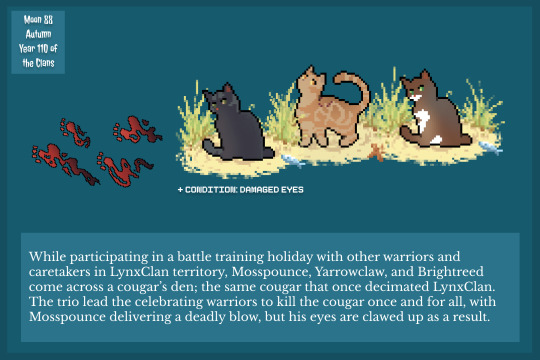
While participating in a battle training holiday with other warriors and caretakers in LynxClan territory, Mosspounce, Yarrowclaw, and Brightreed come across a cougar’s den; the same cougar that once decimated LynxClan. The trio lead the celebrating warriors to kill the cougar once and for all, with Mosspounce delivering a deadly blow, but his eyes are clawed up as a result.
[Image ID: Mosspounce, Brightreed, and Yarrowclaw follow bloody pawprints. Under Mosspounce, it says + CONDITION: DAMAGED EYES.]
(Mosspounce: 49, male, caretaker, adventurous, talented fire-starter)
(Brightreed: 20, male, warrior, righteous, student of art)
(Yarrowclaw: 23, female, warrior, cold, talented fire-starter)
#clangen#warrior cats#rippleclan#warriors#rippleclan story#ravenweaver#mitespark#wolverineheart#shrewpaw#shrewflame#thundergale#clammask#halibutdusk#rustshade#twinekit#burdockcreek#locustseeker#wildclaw#honeybuzz#leathermask#splashtuft#drumtooth#stormjump#carnationspeckle#downstar#mosspounce#brightreed#yarrowclaw
44 notes
·
View notes
Photo
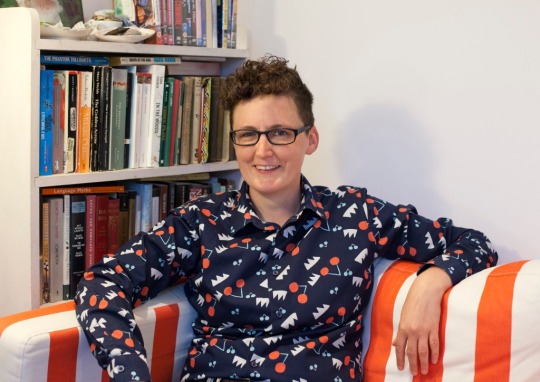
Mo Moulton
Gender: Transgender non binary (they/them)
Sexuality: Queer
DOB: Born 1979
Ethnicity: White - American
Occupation: Historian, writer, professor
#Mo Moulton#lgbt#lgbtq#queerness#nonbinary#non binary#transgender#queer#1979#white#historian#writer#teacher
68 notes
·
View notes
Text
Alex Abad-Santos at Vox:
Despite being a time when people from all over the world come together in equality and peace, the Olympics are still uncertain territory for transgender athletes. There are no transgender athletes who are competing outside of the gender they were assigned at birth at this year’s Games. Transgender women who transitioned after puberty aren’t allowed to compete in major sports on a college level. Athletes Nikki Hiltz, a runner, and Hergie Bacyadan, a boxer, both identify as transgender (Hiltz also identifies as nonbinary), but both have always and continue to compete in the women’s division, which is the sex they were assigned at birth. Athletes who do not identify as trans, like Algerian boxer Imane Khelif, have also been scrutinized for their gender. Along with China’s Lin Yu-ting, Khelif is one of two women boxers who failed a “sex test” from the International Boxing Association last year. They have since been connected to discussions of sports and Differences of Sexual Development (DSD), a rare group of genetic and hormonal disorders allowed under International Olympic Committee guidelines. After Khelif’s Italian competitor Angela Carini conceded their match less than a minute into their bout, many have weighed in, including Elon Musk and J.K. Rowling.
Outside of the Games, trans people face so much backlash, often for simply existing. The conversation around sports is particularly fraught, from children’s athletics right up through the pros. Despite the International Olympic Committee vowing to be more inclusive, the future for trans athletes is unclear. It all raises the question: How did we get to this point, and did it always have to be this way? The answers found in historian and journalist Michael Waters’s The Other Olympians: Fascism, Queerness, and the Making of Modern Sports might be surprising. Waters’s book traces the emergence of Zdeněk Koubek, a track and field star representing the country formerly known as Czechoslovakia who, at 21, won two medals — a gold in the 800m and a bronze in the long jump — at the 1934 Women’s World Games. (The Women’s World Games was the precursor to women competing at the Olympics). In 1935, Koubek announced that he would be living life as a man and swiftly became an international celebrity.
Perhaps the most intriguing facet to Koubek’s story was in the public response. Koubek was more welcomed and celebrated than we might imagine. There was an open-mindedness and empathy to the reception of Koubek and his gender identity and expression in the 1930s. Waters also pinpoints where and when that changed, specifically at the 1936 Olympics in Nazi Germany. Armed with a propensity for eugenics, gender anxiety, and a startling lack of scientific evidence, a small set of Nazi officials influenced the International Olympic Committee into gender surveillance and trans panic — stuff that eerily mirrors the transphobic attacks that athletes, cis and trans alike, face today.
Anti-trans discrimination in the Olympics stretches as far back as the infamous 1936 games in Berlin.
#Olympics#Transgender#Transvestigations#LGBTQ+#Lin Yu Ting#Imane Khelif#Hergie Bacyadan#Nikki Hiltz#Zdeněk Koubek#1936 Berlin Olympics#1936 Summer Olympics
67 notes
·
View notes
Text
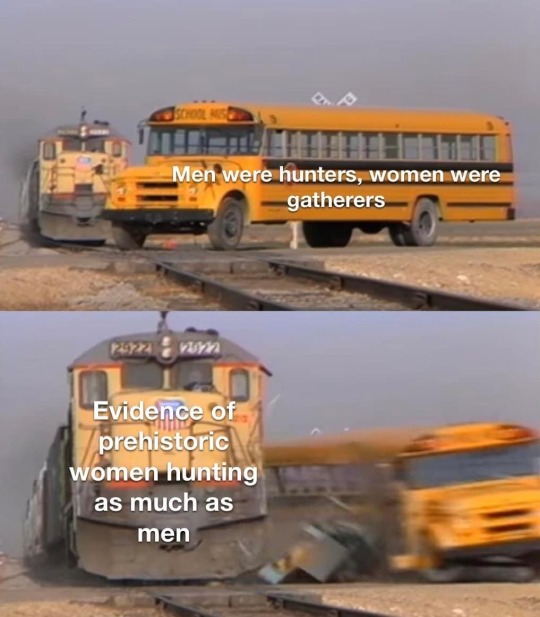
It’s like “gender” is *actually* a social construct or some shit.
And not only is what any gender means very specific to a specific culture, regardless of the phenotype current people link it to, but even then not everyone in that given culture expresses it the same way, and some people *always* push what that gender and gender expression means.
Because “gender” is not only a social construct; it is a *continuously evolving* social construct.
Queer historians are good at noting that “although we might call x a trans man/a gay man/a nonbinary person etc etc if they lived today, these ideas did not make sense in the social context they lived in”. Historians in general need to get better at realising and elucidating that our modern Western concepts of “man” and “woman” are very different from, and in many ways may not even be recognisable, in, say, medieval Europe, Ancient Rome, medieval/early modern Incan societies, early modern Madagascar, prehistoric Pacific Islander societies, Heian period Japan etc etc, just because we are broadly applying them to many people with similar biological phenotypes.
#prehistoric history#history#gender#gender in history#queer history#the fucking victorians and their long fucking shadow in history#women’s history#gender is a continuously evolving social construct
303 notes
·
View notes
Text
I'm always trying to stay on the cutting edge of every permutation of our constantly evolving visual culture but the elusiveness of every new form makes it difficult for me, even as one of the youngest possible millennials. in fashion, my freshman students are all wearing 2000s or "y2k" fashion: baggy grungy or baby phat hiphop, with an elevated touch of modesty, good color theory, and a stark awareness of bodily proportion. in memes, legendary 00s icon, lisa frank. its embarrassing to follow influencers with over 10 mil, now, as if it breaks the parasocial connection.
someone asked yesterday if tiktok is now the premier vehicle of visual culture. I open tiktok. on one side, a zoomed in interview with the mother of a shooting victim. but the other side is a compilation of slime videos, a woman cutting soap, life hacks, and chinese "smart" product placements. you can hear and see both. this bizarre genre, I can only recognize as content. on social media, content is technically anything you can doomscroll, the action of spending over 2 hours on a social media feed, a for you page, a timeline, a dashboard to tumblr addicts.
I'm watching cable TV with a girl I'm seeing. the ads are remarkably only geared towards boomers and older gen x. but, so is the 'content', bad action movies made for cable and reruns of 80s/90s TV shows, but the exact same show marathoned in hours long successions.
to be an effective art historian, I have to take things from this ever-shifting visual culture and translate it into the equally fickle and amorphous art world... so what does 'content' look like for museum shows? my first 100+ object loan show was in part by a colleague, a younger curator at BAMPFA. a massive exhibition of all female nonbinary artists, from the 60s PoMo feminists to the self obsessed identity displayers of today. I absolutely LOVED it. I had no problem enthusiastically flitting from object to object, frontwards and in reverse twice, to spend special time with all my favorites. a fave professor stopped me. I hadn't even recognized him in the excitement. he looked bewildered, but laughed about how giddy I was. he didn't write any criticism on the show. my boss at the time, our museum director, told me she thought it was "such a big mess". my favorite lesbian professor clutched onto her wife with an anxious look. my lesbian artist friend had panic attack and put his headphones on in a dark corner. on the other hand, the younger undergrad girls from berkeley looked elated and delighted, flitting around and oohing and aahing at my same pace. I learned one of them was an engineering student named erin who needed a feminist pickup from the disouragement in her male dominated field.
so how has the 'content' show, or the art world reception to them, changed in the past 4 years? well for one, it seems like major flagship institutions are dropping the mononym altogether. as the french impressionists take over the east coast, none of shows feature one painter as a sole focus, but curators use juxtapositions to keep people interested. in MoMAs, monoynym shows are reserved for major retrospectives or figuratively and literally, monolith artists like simone leigh. the older art historians are hesitant to adapt to these changes. one of my favorite shows this summer, over 300 very different collection pieces packed onto the floor and across the hall, wasn't enjoyed by any of the critics I know. My dates all hated it. except one, a hot ADHD butch who had a tiktok doomscrolling addiction.
what does this mean for the future of how shows are displayed.... how do museums let go of the traditional princely standard: 3.5 inch hangings with a 25 degree downwards tilt? is it better or worse to compromise museums into messy 17th century curiosity cabinets?
47 notes
·
View notes
Note
I kinda felt disappointed and kinda disheartening in the discussion surrounded taash being non-binary and people just framing their gender identity discussion as just baby first queer meetup it just I've been out for several years as non-binary and I still don't have access to these kind of outlets I don't know but I guess people forget that everyone journey is different.
and also like it does make sense for taash experience to be like that since its literally their first time exploring new gender identities?
Hey anon! I think that's exactly it - this isn't at all limited to people talking about Taash or the Veilguard fandom (or people who played and didn't like it) but on some level Taash actually seems to me to exactly play out the (explicitly canon scenario) of "what if you felt like something was weird or off about how you experience yourself but didn't know what and it had been going on so long that you'd internalized it and thought it was normal for everyone and this also got caught up with your complicated relationship with your mother and you blew up at your coworker for walking around in a kinda low cut shirt on her own personal time and instead of being like WELL FUCK YOU TOO she was like 'interesting. why are you doing this because I don't think I'm the problem.' " Like, I was on a lot of feminist websites aimed at young women in the early 2000s as a teen and so lesbianism and bisexuality were both talked about a lot but no one was like, bringing up Kate Bornstein and Leslie Feinberg and actual THEORY until college. Like, truly, until maybe 15 years ago, when social media with an anonymous angle started blowing up? You had your gender and sexuality discovery through doing and living and talking to other queer people irl or by finding a library or bookstore that had what you needed, if you even knew what you needed beyond "I'm weird and feel wrong." You had to go to a group. You can literally read Alison Bechdel's account of doing this for lesbianism in the 80s. Taash is actually just acting like someone who can't privately learn all of this from a carrd and has to actually talk to people and take notes. And as for the actual term...you know how people always mock historians for being like "these two people were close friends" and they're like OH MY GOD THEY WERE FRIENDS WHO WANTED TO BE BURIED TOGETHER? Well, have you considered Taash is referred to as nonbinary and has the whole pronouns discussion because if you go with more euphemistic language, again, someone will be like "no this is just representative of gender nonconformity" and call Taash a tomboy.
I don't want to derail the above but I do feel a lot of people online, especially who have been on social media from a very young age, just...struggle to comprehend the following three things to a degree I find worrying.
perspectives, opinions, and experiences that are different than yours are good things to experience regularly; you should expand your mind and comfort zone
representation does not mean "people who had the same exact experience with the same exact outcomes as you for the same exact gender/sexuality/race/ethnicity/gender" and is just as much to show people not of those demographics the inner life of characters who are
You do not need to like a character as a person to find them interesting or well-written/acted.
and i feel a lot of weirdness towards Taash coming from people who are nb or queer themselves lands in those categories.
25 notes
·
View notes